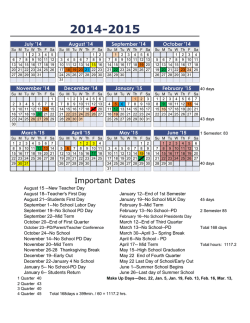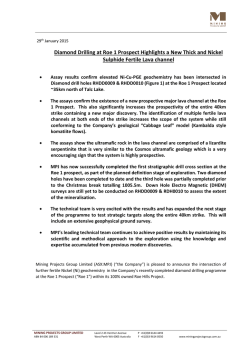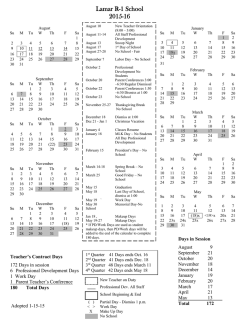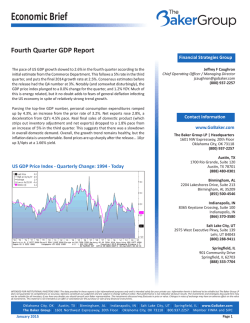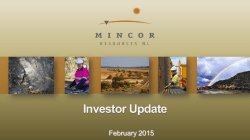
Quarterly activities report for the period ending 31 December 2014
30 January 2015 Quarterly activities report for the period ending 31 December 2014 Highlights Roe Hills Project (W.A. Kambalda Nickel Sulphide Project 100%)
40km strike with new major Nickel Sulphide Lava channels defined at both ends including multiple high grade Nickel Sulphide intersections. Nickel Sulphide intersections include: Talc Lake Prospect
ROE 114: ORTL‐1: ORTL‐1: ORTL‐2: And Recently RHDD0001: RHDD0002: RHDD0008: 1.0m @ 3.53% Ni from 155m (including 0.5m @ 6.15% Ni from 155.5m) 1.9m @ 1.65% Ni from 131.55m 0.15m @ 1.33% Ni from 222.75m 0.3m @ 1.46% Ni from 182.8m 4.3m @ 0.53% Ni from 211.1m (including 0.2m @ 2.66% Ni from 215.2m) 1.0m @ 0.69% Ni from 227.64m 1.3m @ 0.65% Ni from 242.7m Roe 1 Prospect
RHDD0009: RHDD0010: 75.5‐78.5m 299.0‐302.9m 0.46%Ni 0.49%Ni 0.28%Cu 0.42%Cu 128ppbPGE 218ppbPGE The aggregated data including logs, assays, and geophysics from the current exploration programme have clearly defined two major Nickel fertile lava channels highly prospective for major discoveries. The ultramafic lava channels confirm the entire project conforms to the Company’s anticipated geological model (Kambalda style komatiite flows). This has strong correlation to known deposits such as Cosmos, Maggi Hays, Cerberus, Prospero, Sinclair; and is a very important exploration milestone.
12 Diamond Drill holes completed to date totalling 3885m at both the Talc Lake and Roe 1 Prospects. MPJ’s leading Technical Team continues to achieve positive results by maintaining its scientific and methodical approach to the exploration using the knowledge and expertise accumulated from previous modern discoveries. MINING PROJECTS GROUP LIMITED ABN 84 006 189 331 Level 2 43 Ventnor Avenue P +61(0)8 6144 4492 West Perth WA 6005 Australia F +61(0)3 9614 0550 www.miningprojectsgroup.com.au
The planned definition phase of the exploration focused on establishing geological control is complete. The next phase of intensive geophysical surveying and strategic target drilling anticipated to commence in February 2015. NEW NICKEL SULPHIDE TARGETS IDENTIFIED ON FERTILE NICKEL BELT
Roe 1 Prospect
New major Fertile Nickel
Lava Channel defined
Talc Lake Prospect
Major Fertile Nickel
Lava Channel.
Significant high grade Nickel
Sulphide intersection
Figure 1: Earlier identified prospects Roe 1, Roe 2 & Talc Lake were confirmed as targets during the geochemical analysis as well as at least 4 other additional high priority targets. The Study also extended the strike length of the known prospects strike potential. Figure 2: Schematic diagram of the Kambalda “Cabbage Leaf” Model showing the geological position of the mineralisation drilled to date at Talc Lake and the downstream target zone where the formation of massive Nickel Sulphide typically occurs. Talc Lake Prospect
New Nickel Sulphide was intersected at the Talc Lake Prospect (Figure 1 & 3) in Diamond drill holes RHDD0001, RHDD0002 and RHDD0008.
Initial assay results received from Talc Lake confirms the Massive Nickel Sulphide intersections are very significant as they collectively define the core of the lava channel system and indicate the sulphides are derived from a local primary source.
Most importantly a historic Fixed Loop Electromagnetic (FLEM) anomaly on the southern edge of the survey was previously not considered within the system. This anomaly now aligns with the interpreted lava channel direction on the southern side of a known massive sulphur source (sulphidic sediment).
MPJ has now successfully completed the stratigraphic drilling during the planned definition stage of the exploration at Talc Lake which consisted of 8 diamond drill holes totalling 2,888m. Down Hole Electro Magnetic (DHEM) surveys are still yet to be conducted on RHDD0007 & RHDD0008 to confirm further strategic targets. The technical team is very excited with the results and has re‐defined and expanded the next stage of the programme to test strategic targets and ensure capital efficiency. Talc Lake has Nickel mineralisation intersections over a continuous distance of 400m (Figure 3) and recent intersections further confirm that the system is consistent with the Company’s geological “Cabbage Leaf” model (Kambalda style komatiite flows) as shown by (Figure 2). The down plunge extension significantly expands the projects prospectivity of a major discovery as these disseminated styles of mineralisation typically lead to massive Nickel sulphide accumulations downstream (Figure 2). The key intersections from the Talc Lake Prospect (as previously reported) have clearly defined the Nickel hosting channel which MPJ is targeting (Figure 3 & 4);
ROE 114: ORTL‐1: ORTL‐1: ORTL‐2: 1.0m @ 3.53% Ni from 155m ( including 0.5m @ 6.15% Ni from 155.5m ) 1.9m @ 1.65% Ni from 131.55m 0.15m @ 1.33% Ni from 222.75m 0.3m @ 1.46% Ni from 182.8m And Recently RHDD0001: RHDD0002: RHDD0008: 4.3m @ 0.53% Ni from 211.1m (including 0.2m @ 2.66% Ni from 215.2m) 1.0m @ 0.69% Ni from 227.64m 1.3m @ 0.65% Ni from 242.7m Most importantly a potentially large scale target has been recognised in an historic Fixed Loop Electromagnetic (FLEM) survey completed over the Talc Lake area which produced the start of an anomaly on the south‐eastern edge of the survey (Figure 4). The Late Time response FLEM anomaly had not been previously considered due to its proximity to a larger anomaly which was historically drilled and turned out to be a sulphidic shale hosted conductor. This newly recognised anomaly now aligns with the interpreted komatiite channel direction on the southern side of the known massive sulphur source (Figure 4). This same sulphidic unit was intersected to the east of the Nickel mineralisation in RHDD0001 where the lava channel has thermally eroded into the sulphidic shale providing the sulphur source necessary for the formation of the Nickel sulphide mineralisation. This sulphidic shale is a unique‐highly conductive marker horizon and this newly defined FLEM target may be the downstream location of the massive Nickel sulphide accumulation as depicted by the “Cabbage Leaf” model in (Figure 2). Technical Director Neil Hutchison will work closely with the Newexco Team to design and instigate a new High‐Powered Electromagnetic (EM) survey over the lava channel area, extending the survey south‐easterly to fully define the source of this EM anomaly located on the edge of the historic FLEM survey (Figure 4). Figure 3: Talc Lake long‐section showing Nickel Sulphide intersections and geological interpretation. 8 diamond drill holes were successfully completed at Talc Lake totalling 2,888m (Table 1). Down Hole Electro Magnetic (“DHEM”) surveys are still to be conducted on RHDD0007 and RHDD0008 to further confirm strategic targets and will coincide with the surface High‐Powered EM survey in 2015. The technical team is very excited with the results and has expanded the next stage of the programme to test strategic targets and ensure capital efficiency. Table 1: Drill Hole Collar Co‐ordinates. Collar Coordinates: EAST NORTH
MGA94 GRID 461758 6537487
RHDD0001 461677 6537501
RHDD0002 461599 6537518
RHDD0003 461184 6537803
RHDD0004 461108 6537800
RHDD0005 461030 6537804
RHDD0006 462020 6537300
RHDD0007 461860 6537300
RHDD0008 451200 6557600 RHDD0009 451040 6557600 RHDD0010 451040 6557400 RHDD0011* * Note: Hole to be extended and completed. RL
300 300 300 305 305 305 300 300 305 305 305 DIP ‐61 ‐60 ‐60 ‐60
‐60
‐60
‐60
‐60
‐60
‐60
‐60
AZIMUTH 092 090 090 090 090 090 090 090 090 090 090 TOTAL EOH DEPTH
283.40m 354.40m 459.20m 256.40m 337.30m 414.00m 392.60m 390.60m 270.00m 437.50m 290.00m* 3885.40m Figure 4: Drill hole location plan over historic FLEM survey data. Recent drilling (red collars) and historic drilling (orange & blue collars) have defined the channel position and location of the sulphidic shale marker unit. Importantly a new target has been defined by a Late Time Channel EM response on the edge of the FLEM survey area within the interpreted position of the lava channel. This anomaly is located ~1,600m south of RHDD0007 & RHDD0008 and is consistent with the Kambalda Style “Cabbage Leaf” Model. Roe 1 Prospect
Assay results from The Roe 1 Prospect confirm elevated Ni‐Cu‐PGE geochemistry has been intersected in Diamond drill holes RHDD0009 & RHDD0010 (Figure 5) at the Roe 1 located ~35km north of Talc Lake.
The assays confirm the existence of a new prospective major lava channel at the Roe 1 Prospect. This also significantly increases the prospectivity of the entire 40km strike containing a new major discovery. The identification of multiple fertile lava channels at both ends of the strike increases the scope of the system while still conforming to the Company’s geological “Cabbage Leaf” model (Kambalda style komatiite flows).
The assays show the ultramafic rock in the lava channel are comprised of a lizardite serpentinite that is very similar to the Cosmos ultramafic geology which is a very encouraging sign that the system is highly prospective.
MPJ has now successfully completed the first stratigraphic drill cross section at the Roe 1 prospect, as part of the planned definition stage of exploration. Two diamond holes have been completed to date and the third hole was partially completed prior to the Christmas break totalling 1005.5m. Down Hole Electro Magnetic (DHEM) surveys are still yet to be conducted on RHDD0009 & RDH0010 to assess the extent of the mineralisation. The first cross section of the diamond drilling has now been completed at Roe 1, the northern most prospect area at the company’s Roe Hills Project (Figure 5). Elevated Ni‐Cu‐PGE mineralisation (Table 2) was intersected within the core and at the base of a thick (>170m) lizardite serpentinised ultramafic flow which has many similarities and correlations to the Cosmos ultramafic system. Two holes have been completed to date (RHDD0009 & RHDD0010) as shown in Figure 5 and Table 2. This confirms the existence of a thick fertile ‘lizardite’ ultramafic lava channel, with Nickel mineralisation situated in the core and at the base of the system, constituting a growing set of multiple ultramafic pulses. The geology is comparable to that at the Cosmos Nickel Project where the core of the thick lizardite serpentinite system contained large low‐grade disseminated sulphide above the rich massive sulphide deposits which were the result of the early ultramafic pulses depositing high grade Nickel sulphide mineralisation at the base and on the flanks of the ultramafic system (Figure 6). This is very encouraging as the rocks at Roe 1 appear to be the fertile upstream portion of an extensive fertile system and the potential for downstream Nickel sulphide deposition is demonstrated in the schematic diagram of the Kambalda “Cabbage Leaf” Model shown in Figure 3. The confirmation of multiple fertile lava channels at both ends of the 40km strike at Roe Hills increases the scope of the entire system while still conforming to the Company’s geological “Cabbage Leaf” model (Kambalda style komatiite flows) (Figure 2). Four diamond drill holes across 2 cross‐sections had been planned at Roe 1 totalling ~1500m, with 1005.5m completed so far (Table 1). Drill hole RHDD0011 on the second cross‐section was temporarily suspended at a depth of 290m above the anticipated mineralised zone due to equipment failure prior to Christmas. This will be completed at the commencement of the next stage of drilling along with the last planned hole RHDD0012 (Figure 1). The holes were designed to establish geological stratigraphic control so as to bring Roe 1 in line with Talc Lake’s exploration progress. The company looks forward to providing further details on the next stage of exploration following a complete review of all results received to date. It is anticipated work will recommence in February 2015.
Table 2: Maximum assays results from drill core analysis Hole ID Interval m Max Ni% Max Cu% Max PGE ppb (Pt+Pd) RHDD0009 75.5‐78.5m 0.46% 0.28% 128ppb RHDD0010 299.0‐302.9m 0.49% 0.42% 218ppb Figure 5: Roe 1 Prospect long‐section (looking north‐east). Historic drill hole (blue collars) define a Ni‐Cu corridor which indicates a “fertile” lava channel. Four drill holes have been planned (red) to test the geochemical anomaly. Holes RHDD0009 & RHDD0010 have been completed to date. RHDD0011 is in progress and will be completed at the commencement of the next stage of drilling. Figure 6: Cross‐section of the Cosmos Deep Deposits showing the disseminated Anomaly 1 Deposit in the core of the flow and the higher grade Alec Mairs (AM) Deposits at the base and flanking the thick ultramafic flow (image courtesy of Jubilee Mines) Fraser Range East Project (W.A. 100%) The first stage Moving Loop Electromagnetic survey MLEM programme highlighted in Figures 7 and 8 was conducted during May 2014 at the Fraser Range East Project. A total of 94 stations were observed along 7 profiles (Figures 7 & 8) encompassing a total of 18.2 line kilometres. A broad anomaly has been recorded in the mid‐time response of the three westernmost lines (Figures 7 and 8). The anomalous response was recorded over a strike‐length of 800 m although it should be noted that the anomaly is open in both directions. The large wavelength of the anomaly suggests the source is laterally extensive. Best modelling results were achieved using three plate models with low to moderate conductance to represent the source. A reasonable fit to observed data can also be achieved using a single plate. A single best modelled result gives a plate that has a shallow dip to the west and gentle plunge to the north. The three plates were used to account for variations within the unit along strike. The plates are modelling at a depth of between 50‐70m depth and the source of the anomaly is unclear as it may be related to conductive overburden or shallow bedrock responses. Newexco have noted that more geological information could improve and constrain the interpretation. Figure 7: Fraser Range East, Balladonia MLEM stations, channel 20 (6.09 ms) raster image and Maxwell plate models overlaid on TMI RTP image. Figure 8: Fraser Range East MLEM stations over MLEM channel 20 (6.09 ms) raster image overlaid by Maxwell plate models. Dingo Range Project The first stage Moving Loop Electromagnetic survey MLEM and follow‐up Fixed Loop Electromagnetic (FLEM) survey programme highlighted in Figures 9, 10 and 11 was carried out at the Dingo Range Project during June 2014. A total of 438 stations were observed along 34 profiles encompassing a total of 39.4 line kilometres. Due to time constraints the MMI soil sampling was not completed. The MLEM data covers 12 kilometres of strike along variably magnetic source rocks which are presently interpreted to indicate the presence of volcanic, possibly mafic/ultramafic rock beneath pervasive cover. The MLEM indicates that the cover conditions increase in either thickness or conductivity to the northwest. Profiles presented in Figure 14 show the elevated response on the northern lines to the west consistent with an overburden response. Central to the survey a number of weak anomalous responses have been identified. The FLEM survey on line 7053500 covers the strongest of these which confirmed the presence of locally strong conductive cover. Modelling accurately constrained the source to surface as represented by a blue plate in Figure 9. Further weak anomalous responses were identified proximal to this source, which remain to be followed‐
up. However, further geological information is required to put these sources in context. The presence of conductive cover warrants a follow up drill programme to establish the depth of cover, bedrock geology and determine the effectiveness of the MLEM survey. Figure 9: Dingo Range MLEM channel 10 (1 ms) raster image overlaid on TMI RTP raster image including Maxwell model plate of conductive cover generated from the FLEM data. The work carried out by Newexco was the first stage of geophysical exploration completed on both the Fraser Range East and Dingo Range Projects. The Company is very encouraged with the quality of the work and the progressive results received. Further work has been recommended to develop both projects to continue to improve on the positive results. Figure 10: Dingo Range MLEM and FLEM profiles channels Figure 11: Dingo Range FLEM line 7053500 modelling of interpreted conductive cover (blue plate) which is 20 to 24 (6 – 15 ms). extensive along the north‐western margin of the MLEM survey. Black and red profiles represent field and modelled response respectively. Corporate Activities The Company held its 2014 Annual General Meeting on 26 November 2014. All resolutions were passed without amendment. Interests in Mining Tenements Project/Tenements
Location
Held at the end of quarter
Acquired during the quarter
Disposed during the quarter
Roe Hills Project E25/402 E28/1933 E28/1935 E28/2117 E28/2118 W.A., Australia 100% Golden Mountain Project MIN4683 Vic, Australia 0%
100%
Fraser Range Project E69/3082 W.A., Australia
100%
Balladonia Project
E69/3211 W.A., Australia 100%
Dingo Range E53/1731 E53/1732 E53/1733 P53/1624 W.A., Australia 100%
ENDS For further information please contact: Mr Joshua Wellisch Managing Director Mining Projects Group Limited For online Information visit: www.miningprojectsgroup.com.au COMPETENT PERSON STATEMENT: Competent Person: The information in this report that relates to Exploration Results or Mineral Resources is based on information compiled and reviewed by Mr N Hutchison, who is a Non‐Exec Director for Mining Projects Group and who is a Member of The Australian Institute of Geoscientists. Mr Hutchison has sufficient experience which is relevant to the style of mineralisation and type of deposits under consideration and to the activity which he is undertaking to qualify as a Competent Person as defined in the 2012 Edition of the ‘Australasian Code for Reporting of Exploration Results, Mineral Resources and Ore Reserves.’ (the JORC Code 2012). Mr Hutchison has consented to the inclusion in the report of the matters based on his information in the form and context in which it appears. The Australian Securities Exchange has not reviewed and does not accept responsibility for the accuracy or adequacy of this release. Appendix 5B
Mining Exploration Entity Quarterly Report
Rule 5.5
Appendix 5B – 2nd Quarter
Mining Exploration Entity and Oil and Gas Exploration Entity
Quarterly Report
Introduced 01/07/96 Origin Appendix 8 Amended 01/07/97, 01/07/98, 30/09/01, 01/06/10, 17/12/10, 01/05/2013
Name of Entity:
Mining Projects Group Limited
(ASX:MPJ)
ABN:
Quarter Ended ('Current Quarter')
84 006 189 331
31st December 2014
Consolidated Statement of Cash Flows
Cash Flows Related to Operating Activities
1.1
Receipts from product sales and related debtors
1.2
Payments for:
(a) exploration and evaluation
(b) development
(c) production
(d) administration
(e) contract services
1.3
1.4
1.5
1.6
1.7
Dividends received
Interest and other items of a similar nature
received
Interest and other costs of finance paid
Income taxes paid
Other (provide details if material)
Net Operating Cash Flows
Current Quarter
$A’000
Year-to-Date
(6 months)
$A’000
-
-
(507)
(114)
(141)
(808)
(197)
(355)
2
7
-
-
(760)
(1,353)
(4)
-
(4)
-
-
-
(4)
(4)
Cash Flows Related to Investing Activities
1.8
1.9
1.10
1.11
1.12
Payment for purchases of:
(a) prospects
(b) equity investments
(c) other fixed assets
(d) physical non-current assets
(e) other non-current assets
Proceeds from sale of:
(a) business
(b) equity investments
(c) other fixed assets
Loans to other entities
Loans repaid by other entities
Other (provide details if material)
Net Investing Cash Flows
29/01/10
Appendix 5B Page 1
Appendix 5B
Mining Exploration Entity Quarterly Report
1.13
Total Operating and Investing Cash Flows
(764)
Current Quarter
$A’000
1.13
Total Operating and Investing Cash Flows
(Carried Forward)
(1,357)
Year-to-Date
(6 months)
$A’000
(764)
(1,357)
6
(10)
-
1,404
(102)
-
(4)
1,302
Net Increase / (Decrease) in Cash Held
(768)
(55)
1.20
1.21
Cash at beginning of quarter/year to date
Exchange rate adjustments to item 1.20
859
-
146
-
1.22
Cash at End of Quarter
91
91
Cash Flows Related to Financing Activities
1.14
1.15
1.16
1.17
1.18
1.19a
1.19b
Proceeds from issues of shares, options, etc.
Proceeds from sale of forfeited shares
Proceeds from borrowings
Repayment of borrowings
Dividends paid
Other – Capital Raising Costs
Other – Share Buy-back
Net Financing Cash Flows
Payments to Directors of the Entity and Associates of the Directors
Payments to Related Entities of the Entity and Associates of the Related Entities
Current Quarter
$A'000
1.23
Aggregate amount of payments to the parties included in item 1.2
1.24
Aggregate amount of loans to the parties included in item 1.10
1.25
Explanation necessary for an understanding of the transactions
91
-
Salaries, Directors’ fees, corporate advisory & consulting fees at normal commercial rates
Non-Cash Financing and Investing Activities
2.1
Details of financing and investing transactions which have had a material effect on consolidated assets
and liabilities but did not involve cash flows
The Company has issued 7,933,334 ordinary MPJ shares to Neil Hutchison in lieu of cash payment for
geological consultancy services provided to the Company.
2.2
Details of outlays made by other entities to establish or increase their share in projects in which the
reporting entity has an interest
-
29/01/10
Appendix 5B Page 2
Appendix 5B
Mining Exploration Entity Quarterly Report
Financing Facilities Available
Add notes as necessary for an understanding of the position.
3.1
Loan facilities
3.2
Credit standby arrangements
Amount Available
$A’000
-
Amount Used
$A’000
-
-
-
Estimated Cash Outflows for Next Quarter
$A’000
4.1
Exploration and evaluation
380
4.2
Development
-
4.3
Production
-
4.4
Administration
4.5
Contract Services
100
480
Total:
*
The Company will rely on its existing cash resources and future capital raising (either debt and/or equity) to funds its current activities. The Company will consider raising further funds from the placement of equity securities, including the utilisation of the equity available under Chapter 7 of ASX Listing Rules. The Company will also consider other fund raising alternatives such as debt instruments, if so required. The Company will only undertake any future exploration programs on the basis that it raised subsequent funds. In light of the above factors, the Company believes that it will have sufficient cash to fund its existing activities (and future activities subject to future funds raised). The Company expects to have negative cashflows from operations of approximately $480,000 for the forthcoming quarter. The Company’s Board and Management is focused on meeting its current objectives and confirm that it is in compliance with ASX Listing Rules, in particular, Listing Rule 3.1. Reconciliation of Cash
Reconciliation of cash at the end of the quarter
(as shown in the consolidated statement of cash flows)
to the related items in the accounts is as follows.
5.1
Cash on hand and at bank
5.2
Deposits at call
5.3
Bank overdraft
5.4
Other (provide details)
Total: Cash at End of Quarter (item 1.22)
29/01/10
Current Quarter
$A’000
Previous Quarter
$A’000
91
859
-
-
-
-
-
-
91
859
Appendix 5B Page 3
Appendix 5B
Mining Exploration Entity Quarterly Report
Changes in Interests in Mining Tenements
Tenement
Reference
6.1
6.2
Interests in mining
tenements relinquished,
reduced or lapsed
Interests in mining
tenements acquired or
increased
Nature of Interest
(note (2))
Interest at
Beginning
of Quarter
Interest at
End of
Quarter
MIN4683
Relinquished
100%
0%
-
-
-
-
Refer to schedule above
29/01/10
Appendix 5B Page 4
Appendix 5B
Mining Exploration Entity Quarterly Report
Issued and Quoted Securities at End of Current Quarter
Description includes rate of interest and any redemption or conversion rights together with prices and dates.
Total
Number
Number
Quoted
Issue Price Per Security
(cents)
(see note 3)
Amount Paid
Up Per
Security
(cents) (see note
3)
7.1
7.2
+Securities
Preference
(Description)
Changes During Quarter
(a) Increases through
issues
(b) Decreases through
returns of capital, buybacks, redemptions
7.3
+Ordinary
7.4
Changes during quarter
(a) Increases through
issues
Securities
(b) Decreases through
returns of capital, buybacks
7.5
7.6
7.7
+Convertible debt
securities (Description)
Changes during quarter
(a) Increases through
issues
(b) Decreases through
securities matured,
converted
Options
(Description and
Conversion Factor)
7.8
Issued during quarter
7.9
Consolidation during
quarter
Exercised during quarter
7.10
Expired during quarter
7.11
Debentures
(totals only)
Unsecured notes
(totals only)
7.12
29/01/10
-
-
-
-
-
-
-
-
-
-
-
-
1,260,887,483
1,260,887,483
-
-
7,933,334
7,933,334
$0.009
$0.009
-
-
-
-
-
-
-
-
-
-
-
-
-
-
-
-
677,744,442
677,744,442
Exercisable @ $0.010
-
91,400,000
91,400,000
Exercisable at $0.01 to
$0.50
-
283,000,000
283,000,000
Exercisable @ $0.010
-
-
-
-
-
-
-
-
-
105,282,868
105,282,868
Exercisable @ $0.015
-
-
-
-
-
-
-
-
-
Appendix 5B Page 5
Appendix 5B
Mining Exploration Entity Quarterly Report
Compliance Statement
1
This statement has been prepared under accounting policies which comply with accounting
standards as defined in the Corporations Act or other standards acceptable to ASX (see note
4).
2
This statement does give a true and fair view of the matters disclosed.
Sign Here:
Date: Friday 30 January 2015
Managing Director
Print Name:
Joshua Wellisch
Notes
1
The quarterly report provides a basis for informing the market how the entity’s activities
have been financed for the past quarter and the effect on its cash position. An entity
wanting to disclose additional information is encouraged to do so, in a note or notes
attached to this report.
2
The “Nature of interest” (items 6.1 and 6.2) includes options in respect of interests in
mining tenements acquired, exercised or lapsed during the reporting period. If the entity is
involved in a joint venture agreement and there are conditions precedent which will change
its percentage interest in a mining tenement, it should disclose the change of percentage
interest and conditions precedent in the list required for items 6.1 and 6.2.
3
Issued and quoted securities
The issue price and amount paid up is not required in items 7.1 and 7.3 for fully paid
securities.
4
The definitions in, and provisions of, AASB 1022: Accounting for Extractive Industries and
AASB 1026: Statement of Cash Flows apply to this report.
5
Accounting Standards
ASX will accept, for example, the use of International Accounting Standards for foreign
entities. If the standards used do not address a topic, the Australian standard on that topic
(if any) must be complied with.
== == == == ==
29/01/10
Appendix 5B Page 6
© Copyright 2025
